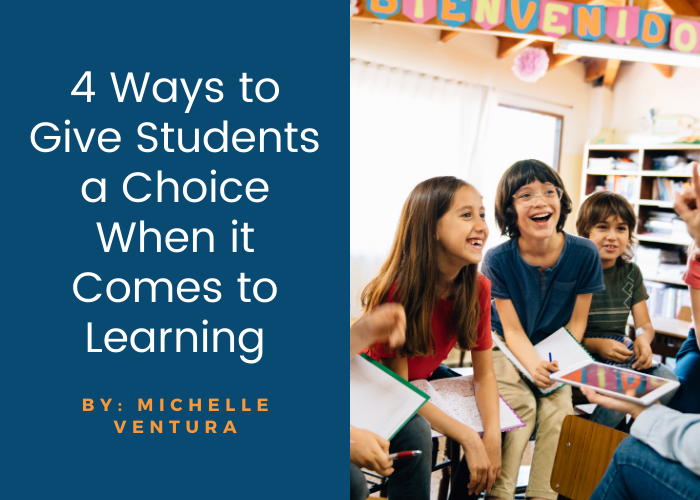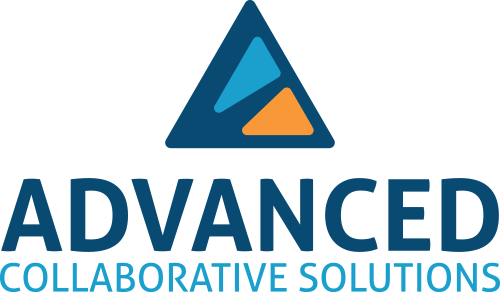4 Ways to Give Students a Choice When it Comes to Learning

By: Michelle Ventura
Let’s face it; when students are not engaged, learning declines. Student boredom is a reality that isn’t helped by the closure of school buildings, though many in-person classrooms are impacted too. But why is this so important? According to the Visible Learning research, boredom has an effect size of -0.47, which means that schools will see negative impacts on student achievement when students aren’t engaged. Likewise, when students are engaged in content and excited to learn, they become empowered learners, and student achievement soars!
Research has shown that giving students a choice over their learning is very motivating, makes kids excited to learn, and ultimately leads to better outcomes. This is often referred to as the Self-Determination Theory, where students are deeply engaged and do their best creative work when they feel that they are acting according to their own will on behalf of goals they find meaningful. (Deci and Ryan, University of Rochester) Students will want to explore and complete tasks they feel passionate about because they will be intrinsically motivated. Having that motivation to learn becomes increasingly important when students are learning from a distance, specifically during asynchronous learning.
With any instructional model, teachers need to develop learning progressions, which include learning intentions (what students must learn) and success criteria (how students know they have mastered the learning) for each lesson or unit and set goals for learning, ideally alongside students. These progressions and goals can be used to guide yourself and your students in knowing that the expectations and learning were fully met.
Here are four ways to increase student engagement by allowing students to own their learning. Note that the four strategies listed here make for an effective blended learning opportunity, meaning that students can be engaged with both offline and online learning experiences. Moreover, these strategies help to build more student agency, choice, and voice into specific learning activities.
Project-Based Learning
Project-based learning (PBL) is the idea of having students learn about a topic and show mastery of a subject by completing a project done as a group or independently. Some teachers define PBL units differently, including the model where a PBL unit is completely independent, and students drive their own learning, based on a problem or challenge, and present a culminating product. Others teach along the way and have students choose a project, possibly even from a menu, to culminate the learning. Instead of a unit test or summative assignment, students design a project to show what they know. By using this method, students value the learning as it helps them create their end result.
One example would be a sixth grade social studies ancient Egypt unit where the teacher teaches the content and students choose a format to display their learning. Examples of culmination projects in a recent class included:
- A game board using key vocabulary words and concepts
- A three-dimensional map of ancient Egypt using the places learned about
- A scrapbook and journal depicting life in ancient Egypt
- A news report style video about ancient Egypt
Teachers can follow a similar model grouping students and having them use the jigsaw method to learn new content before completing a project of their choice to show they have mastered all the unit’s learning intentions and goals.
PBL experts such as PBLWorks or CraftED have tons of online resources, project examples, and videos to help educators conduct PBL projects in person or from a distance.
Menu Boards
Menu boards give students options over how they will learn new concepts or complete a unit. By allowing students to choose one or even a few tasks, engagement increases because students own their learning, and their sense of empowerment increases.
Some great examples include tic-tac-toe or digital choice boards, where students choose three items to complete. Others have restaurant style menus where students must choose multiple “courses” to learn and show mastery or learning.
Check out this example from a sixth grade health final.
Another excellent example of an Algebra I menu board comes from secondary instructional math coach, Rachel Mane, from Northeast Independent School District in San Antonio, Texas. Rachel designed an Algebra I cumulative review where students choose the order and which standards they review with immediate feedback. See the full example here.
Menu boards work well for virtual learning as students can choose assignments that they are most interested in and even meet with the teacher or other students during office hours or work sessions as needed.
Virtual Field Trips
Even if you are learning in person, field trips are not always an option due to budget and time constraints. Due to the global pandemic, virtual field trips became much more common and accessible and are an easy way to supplement PBLs, menu boards, or regular classroom instruction. Many museums, national parks, state parks, universities, zoos, and more offer virtual experiences of their venues. Consider ways to supplement your curriculum with virtual field trips.
For middle school students, a great example of using remote field trips is a virtual tour of the Lascaux Cave in France. It is a realistic exploration for students when studying the development of early humans. Students get to experience what it must have felt like in the prehistoric era as they travel throughout the underground tunnels.
For more examples of virtual field trips check out We Are Teachers and Good Housekeeping.
Novel Studies
Use a novel or book that your students are excited about to tie science, math, art, or social studies to the literature. Whether your students are early readers or independent readers, you can use literature to explore various subject areas.
A great example of a novel study for fourth grade uses the popular novel Island of the Blue Dolphins. Through this novel, students explore a variety of subjects, including:
- Science: ocean animals, survival skills, resources, tsunamis, and earthquakes
- Social Studies: California Native Indians, movement of people in North America (Aleuts)
- Math: measurement, time
- Geography: island, California
- Language Arts: sensory details, journal writing, vocabulary, newspaper
Younger readers can model a similar concept for popular children’s books. One example is Storytime STEM-Packs, which are STEM-based lessons from popular children’s stories like Giraffes Can’t Dance or peg+cat, aimed at a K-3 audience. These resources are great for introducing STEM concepts into a storybook unit of study.
Not only does student choice motivate and engage learners, it addresses student learning loss due to COVID-19 school building closures. Accelerating instruction has taken center stage, as teachers must preserve core instructional time with minimal distractions. Last spring, the most widely accepted approach to virtual learning was to provide stop-gap instruction, meaning that before teachers introduced new content, they provide content to keep students in the education game. But with serious gaps in achievement becoming more apparent each day, there is a new found commitment to grade-level instruction.
When it comes to learning, the more excited students are to learn, the more they will drive their own learning, value the content taught, and meet and exceed the goals they set for themselves. Remember, the overriding purpose behind all of these recommendations is to accelerate learning while helping as many students as possible.

